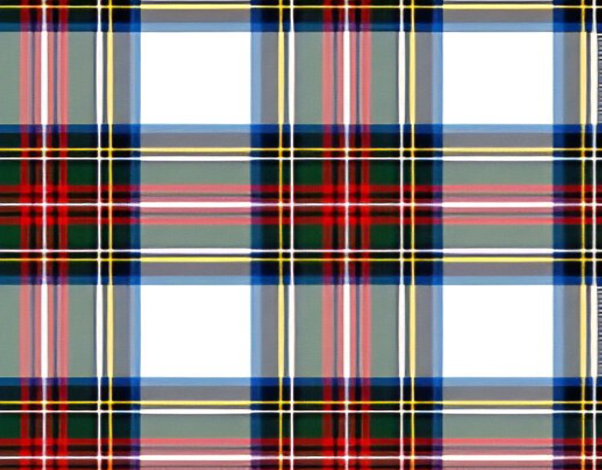
Tartan, that quintessentially Scottish pattern of crisscrossed horizontal and vertical bands in multiple colors, isn’t just a style statement—it’s a historic emblem of Scottish heritage. Among the various tartans, the Stewart Tartan stands out with its vibrant colors and royal connections, making it one of the most recognizable and revered patterns in Scottish history. Traditionally associated with the powerful Stewart family, who ascended to the Scottish throne through Walter Stewart in the 12th century, this tartan symbolizes a lineage that has significantly shaped Scotland’s history. The bold reds and blues of the Stewart Tartan not only reflect the family’s royal status but also serve as a visual reminder of their enduring influence over the centuries. This tartan has been donned by highlanders and kings alike, marking ceremonies and battlefields, embedding itself as a cornerstone of Scottish cultural identity. It carries with it stories of bravery, leadership, and the turbulent history of Scotland’s monarchies, resonating with the deep-seated pride of the Scottish people.
The Royal Roots of Stewart Tartan
The Stewart Tartan, also known as Royal Stewart, is primarily associated with the royal house of Stewart, who ruled Scotland from the 14th century until the unification with England in 1707. This tartan’s rich red background, punctuated with green, blue, yellow, and white, is not just a random selection of colors. Each hue tells a part of the royal story, representing the land, the people, and the regal history of the Stewarts. Significantly, the Dress Stewart Tartan, a variation with a softer color palette, offers a less vibrant but equally prestigious alternative, suitable for formal garments and accessories. It brings the historical significance of the Stewart lineage into everyday fashion, allowing for broader use in modern attire.
A Cultural Emblem
Beyond its royal significance, the Stewart Tartan has grown to represent Scotland globally. It appears in various forms, from kilts and scarves to caps and ties, making it a versatile symbol of Scottish identity. Its prominence peaks every year during the Highland games and other cultural celebrations, where it’s a common sight on kilts and other traditional Scottish attire. The Dress Stewart Tartan, with its muted tones, is often chosen for kilts and dresses that require a subtler, yet still distinctively Scottish, appearance. This variant ensures that the Stewart Tartan remains a flexible and appealing choice for various settings, embodying a blend of tradition and modernity. As it weaves its way through public events, private ceremonies, and even into the office on a tie or a scarf, the tartan acts as a continuous reminder of Scotland’s rich cultural fabric. It celebrates the history and the ongoing story of the Scottish people, adapting effortlessly to both ceremonial and casual contexts. Its ability to stand out in a globalized world as a marker of identity and heritage speaks to its enduring appeal and cultural significance, making the Stewart Tartan a timeless emblem of Scotland’s proud legacy.
Stewart Tartan Today
Today, the Stewart Tartan has transcended its origins to become a global icon of Scottish heritage. It is often seen at Scottish weddings, where tradition dictates that the groom and other men wear kilts featuring their family tartan. For those without a family tartan, the Royal Stewart provides a universally recognized alternative, suitable for anyone to wear as it symbolizes a connection to Scotland’s noble past. The Dress Stewart Tartan has also found popularity in women’s fashion, especially in dresses and skirts that cater to a desire for heritage-rich yet contemporary clothing options, enhancing the tartan’s presence in both traditional and modern fashion circles. Its adoption by designers around the world has seen the Stewart Tartan appear on international runways, in the collections of luxury brands, and incorporated into the designs of everyday streetwear, bridging Scottish tradition with global fashion trends. This widespread use not only underscores the tartan’s versatility but also its ability to adapt to different cultural contexts while maintaining its iconic status.
Symbolism and Identity
The Stewart Tartan is more than just a pattern; it’s a bearer of identity and a connector of individuals to their Scottish roots. For Scots around the world, wearing this tartan, particularly in the form of a kilt, is a proud declaration of heritage. It is also a way for individuals without Scottish ancestry to express admiration and respect for Scotland and its history. Especially significant is the Dress Stewart Tartan, which allows for a more versatile and subdued expression of Scottish pride, ideal for formal occasions and everyday wear alike. This adaptability makes the tartan not just a symbol of Scottish identity but a practical choice for diverse fashion needs, including kilts. Moreover, it offers a tactile connection to Scottish culture, allowing anyone who dons it, regardless of their origin, to partake in the storied history and vibrant culture of Scotland. This universal appeal helps strengthen the bonds among the Scottish diaspora and invites others to explore and appreciate the rich tapestry of Scottish heritage.
Inclusivity and Accessibility
One of the beautiful aspects of the Stewart Tartan is its inclusivity. While some tartans are exclusive to specific clans and families, the Royal Stewart Tartan is available for anyone to wear. This accessibility makes it a unifying symbol, especially during events where expressing a collective Scottish identity is the goal. The Dress Stewart Tartan plays a crucial role in making the historic appeal of the Stewart family accessible and enjoyable to a wider audience, enabling more people to participate in the tradition, regardless of their connection to a Scottish clan.
Conclusion
The Stewart Tartan is a powerful emblem of Scotland’s rich history and vibrant culture. It represents the regality of the Scottish monarchy and the rugged beauty of the Highlands. Whether draped on the shoulders of a bridegroom in a kilt or incorporated into the latest high fashion runway designs, the Stewart Tartan continues to be a timeless tribute to Scotland’s illustrious past and its dynamic present. With both the Royal and Dress Stewart Tartans available, this pattern provides a bridge between ancient traditions and contemporary trends, uniting people around the world with its narrative of power, pride, and collective identity. As we move forward, the tartan’s vibrant threads weave together the past and present, making it an ever-relevant symbol of heritage and unity.
Frequently Asked Questions (FAQs)
- What is the historical significance of the Stewart Tartan?
The Stewart Tartan is historically significant as it is associated with the royal House of Stewart, who ruled Scotland from the 14th century until the union with England in 1707. This tartan symbolizes the lineage of the Stewart family, reflecting their royal status and influence throughout Scottish history. Its distinctive colors and pattern have marked countless ceremonies and have been a part of Scotland’s cultural identity for centuries.
- Can anyone wear the Stewart Tartan?
While tartans were traditionally used to represent and identify different Scottish clans and families, the Royal Stewart Tartan is one of the few tartans that anyone can wear. It is considered a universal tartan, making it accessible and suitable for individuals without Scottish ancestry as well as for those who wish to show their affinity for Scottish heritage and culture.
- How is the Dress Stewart Tartan different from the Royal Stewart Tartan?
The Dress Stewart Tartan is a variation of the traditional Royal Stewart Tartan, featuring a softer and more subdued color palette. It is designed for more formal attire and situations where a less vibrant tartan is appropriate. This makes it particularly popular in women’s fashion, such as dresses and skirts, where it offers a heritage-rich yet contemporary aesthetic.
- What role does the Stewart Tartan play in modern Scottish culture?
In modern Scottish culture, the Stewart Tartan continues to be a symbol of pride and identity. It is prominently featured during cultural celebrations such as the Highland games, in traditional Scottish attire like kilts, and at weddings. Additionally, its incorporation into contemporary fashion and various merchandise globally showcases its ongoing relevance and the enduring connection it provides to Scottish heritage.
- How has the Stewart Tartan been adopted in global fashion trends?
The Stewart Tartan has transcended its traditional roots to become a staple in global fashion. It is used by designers around the world in their runway collections and is incorporated into everyday streetwear, luxury brands, and accessory lines. This widespread use highlights the tartan’s versatility and its ability to blend Scottish tradition with modern fashion trends, thereby maintaining its iconic status across different cultural contexts.



